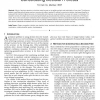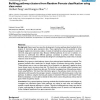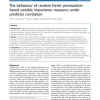29 search results - page 2 / 6 » Spatiotemporal Relational Random Forests |
PAMI
1998
13 years 5 months ago
1998
—Much of previous attention on decision trees focuses on the splitting criteria and optimization of tree sizes. The dilemma between overfitting and achieving maximum accuracy is ...
BMCBI
2008
13 years 5 months ago
2008
Background: Recent years have seen the development of various pathway-based methods for the analysis of microarray gene expression data. These approaches have the potential to bri...
BMCBI
2010
13 years 5 months ago
2010
Background: Random forests (RF) have been increasingly used in applications such as genome-wide association and microarray studies where predictor correlation is frequently observ...
ESANN
2006
13 years 7 months ago
2006
Random Forests were introduced by Breiman for feature (variable) selection and improved predictions for decision tree models. The resulting model is often superior to AdaBoost and ...
ACRI
2004
Springer
13 years 11 months ago
2004
Springer
Abstract. We outline the basic principles of neuropercolation, a generalized percolation model motivated by the dynamical properties of the neuropil, the densely interconnected neu...



